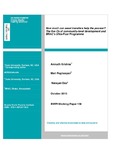| dc.description.abstract | We develop a framework for assessing community-level development programs, building upon five related elements that are centrally important: confidence, cohesion, capacity, connections and cash (the five ‘Cs’). We use this framework for evaluating the impacts over a six-year period (2002-2008) of an innovative program, implemented in rural Bangladesh, which has assisted extremely poor households, literally the poorest of the poor. Asset transfers constitute the centrepiece of this multidimensional program, which also supports training, organization building, cash supports, microfinance, and so on. The provision of a substantial dose of assets has helped produce very positive results by and large. Impressive income gains have been achieved (and sustained) by the majority of assisted households. But vulnerability to downturns on account of negative events, such as illnesses and house damage, has resulted in asset losses for several assisted households. Better social protection measures will help complete the good work commenced by the asset transfer plan. | en_US |

